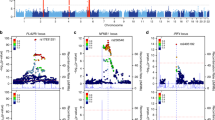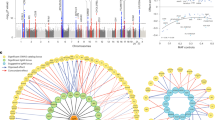Abstract
End-stage renal disease (ESRD) is a major public health problem, affecting 1 in 1,000 individuals and with an annual death rate of 20% despite dialysis treatment1,2. IgA nephropathy (IgAN) is the most common form of glomerulonephritis, a principal cause of ESRD worldwide1,2; it affects up to 1.3% of the population3,4,5,6 and its pathogenesis is unknown. Kidneys of people with IgAN show deposits of IgA-containing immune complexes with proliferation of the glomerular mesangium (Fig. 1). Typical clinical features include onset before age 40 with haematuria and proteinuria (blood and protein in the urine), and episodes of gross haematuria following mucosal infections are common; 30% of patients develop progressive renal failure6,7,8,9. Although not generally considered a hereditary disease, striking ethnic variation in prevalence1,2,3,4,5,6,10 and familial clustering11,12,13,14,15,16, along with subclinical renal abnormalities among relatives of IgAN cases9,14,15,16, have suggested a heretofore undefined genetic component. By genome-wide analysis of linkage in 30 multiplex IgAN kindreds, we demonstrate linkage of IgAN to 6q22–23 under a dominant model of transmission with incomplete penetrance, with a lod score of 5.6 and 60% of kindreds linked. These findings for the first time indicate the existence of a locus with large effect on development of IgAN and identify the chromosomal location of this disease gene.
This is a preview of subscription content, access via your institution
Access options
Subscribe to this journal
Receive 12 print issues and online access
$209.00 per year
only $17.42 per issue
Buy this article
- Purchase on Springer Link
- Instant access to full article PDF
Prices may be subject to local taxes which are calculated during checkout



Similar content being viewed by others
References
U.S. Renal Data System, USRDS 1999 Annual Data Report, National Institute of Health, National Institute of Diabetes and Digestive and Kidney Diseases, Bethesda.
Maisonneuve, P. et al. Distribution of primary renal diseases leading to end-stage renal failure in the United States, Europe, and Australia/New Zealand: results from an international comparative study. Am. J. Kidney Dis. 35, 157–165 (2000).
Varis, J. et al. Immunoglobulin and complement deposition in glomeruli of 756 subjects who had committed suicide or met with a violent death. J. Clin. Pathol. 46, 607–610 (1993).
D'Amico, G. The commonest glomerulonephritis in the world: IgA nephropathy. Q. J. Med. 64, 709–727 ( 1987).
Julian, B.A., Waldo, F.B., Rifai, A. & Mestecky, J. IgA nephropathy, the most common glomerulonephritis worldwide. A neglected disease in the United States? Am. J. Med. 84, 129– 132 (1988).
Schena, F.P. A retrospective analysis of the natural history of primary IgA nephropathy worldwide. Am. J. Med. 89, 209– 215 (1990).
Ibels, L.S. & Gyory, A.Z. IgA nephropathy: analysis of the natural history, important factors in the progression of renal disease, and a review of the literature. Medicine 73, 79–102 (1994).
Julian, B.A., Tomana, M., Novak, J. & Mestecky, J. Progress in the pathogenesis of IgA nephropathy. Adv. Nephrol. Necker Hosp. 29, 53–72 ( 1999).
Schena, F.P. Immunogenetic aspects of primary IgA nephropathy. Kidney Int. 48, 1998–2013 (1995).
Jennette, J.C, Wall, S.D. & Wilkman, A.S. Low incidence of IgA nephropathy in blacks . Kidney Int. 28, 944–950 (1985).
Hoy, W.E., Hughson, M.D., Smith, S.M. & Megill, D.M. Mesangial proliferative glomerulonephritis in southwestern American Indians . Am. J. Kidney Dis. 21, 486– 496 (1993).
Julian, B.A. et al. Familial IgA nephropathy. Evidence of an inherited mechanism of disease. N. Engl. J. Med. 312, 202– 208 (1985).
Wyatt, R.J. et al. Regionalization in hereditary IgA nephropathy. Am. J. Hum. Genet. 41, 36–50 (1987).
Scolari, F. et al. Familial clustering of IgA nephropathy: further evidence in an Italian population. Am. J. Kidney Dis. 33, 857–865 (1999).
Scolari, F. et al. Familial occurrence of primary glomerulonephritis: evidence for a role of genetic factors. Nephrol. Dial. Transplant. 7, 587–596 (1992).
Schena, F.P., Scivittaro, V. & Ranieri, E. IgA nephropathy: pros and cons for a familial disease . Contrib. Nephrol. 104, 36– 45 (1993).
Yano, N. et al. Polymorphism in the Iα1 germ-line transcript regulatory region and IgA productivity in patients with IgA nephropathy. J. Immunol. 160, 4936–4942 (1998).
Fennessy, M. et al. HLA-DQ gene polymorphism in primary IgA nephropathy in three European populations. Kidney Int. 49, 477 –480 (1996).
Allen, A.C., Topham, P.S., Harper, S.J. & Feehally, J. Leukocyte beta 1,3 galactosyltransferase activity in IgA nephropathy. Nephrol. Dial. Transplant. 12, 701– 706 (1997).
van Zandbergen, G. et al. Reduced binding of immunoglobulin A (IgA) from patients with primary IgA nephropathy to the myeloid IgA Fc-receptor, CD89. Nephrol. Dial. Transplant. 13, 3058– 3064 (1998).
Zheng, F. et al. Uteroglobin is essential in preventing immunoglobulin A nephropathy in mice. Nature Med. 5, 1018– 1025 (1999).
Faraway, J.J. Distribution of the admixture test for the detection of linkage under heterogeneity . Genet. Epidemiol. 10, 75– 83 (1993).
Lander, E.S. & Kruglyak, L. Genetic dissection of complex traits: guidelines for interpreting and reporting linkage results . Nature Genet. 11, 241– 247 (1995).
Stephens, J.C., Briscoe, D. & O'Brien, S.J. Mapping by admixture linkage disequilibrium in human populations: limits and guidelines. Am. J. Hum. Genet. 55, 809–824 ( 1994).
Craig, H.D. et al. Multilocus linkage identifies two new loci for a mendelian form of stroke, cerebral cavernous malformation, at 7p15–13 and 3q25.2-27 . Hum. Mol. Genet. 7, 1851– 1858 (1998).
Lathrop, G. M. & Lalouel, J.-M. Easy calculations of lod scores and genetic risks on small computers. Am. J. Hum. Genet. 36, 460–465 ( 1984).
Kruglyak, L., Daly, M.J., Reeve-Daly, M.P. & Lander, E.S. Parametric and nonparametric linkage analysis: a unified multipoint approach . Am. J. Hum. Genet. 58, 1347– 1363 (1996).
Terwilliger, J.D. A powerful likelihood method for the analysis of linkage disequilibrium between trait loci and one or more polymorphic marker loci. Am. J. Hum. Genet. 56, 777–787 ( 1995).
Zhang, Z. et al. Human uteroglobin gene: structure, subchromosomal localization, and polymorphism. DNA Cell. Biol. 16, 73 –83 (1997).
Simon, D.B. et al. Gitelman's variant of Bartter's syndrome, inherited hypokalaemic alkalosis, is caused by mutations in the thiazide-sensitive Na-Cl cotransporter . Nature Genet. 12, 24– 30 (1996).
Acknowledgements
We thank the members of the kindreds for participation; J. Budzinack for database assistance; M. Kashgarian for review of renal pathology; K. Choate for technical assistance; and N. Risch for helpful discussions. A.G.G. was supported by National Institutes of Health training grant and a gift by H. Printz. R.P.L. is an investigator of the Howard Hughes Medical Institute.
Author information
Authors and Affiliations
Corresponding author
Supplementary information
Rights and permissions
About this article
Cite this article
Gharavi, A., Yan, Y., Scolari, F. et al. IgA nephropathy, the most common cause of glomerulonephritis, is linked to 6q22–23. Nat Genet 26, 354–357 (2000). https://doi.org/10.1038/81677
Received:
Accepted:
Issue Date:
DOI: https://doi.org/10.1038/81677
This article is cited by
-
Differences of clinicopathological characteristics and outcomes of IgA nephropathy patients with and without nephrotic syndrome
International Urology and Nephrology (2024)
-
Identifying potential biomarkers for the diagnosis and treatment of IgA nephropathy based on bioinformatics analysis
BMC Medical Genomics (2023)
-
Treatment strategy with multidrug therapy and tonsillectomy pulse therapy for childhood-onset severe IgA nephropathy
Clinical and Experimental Nephrology (2022)
-
The mucosal immune system and IgA nephropathy
Seminars in Immunopathology (2021)



